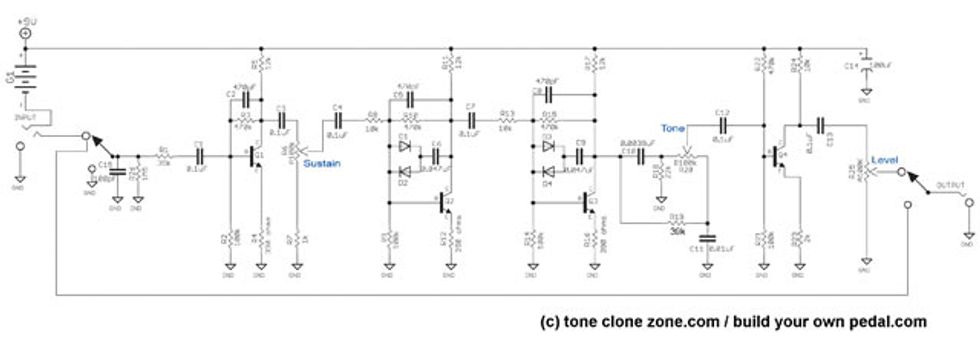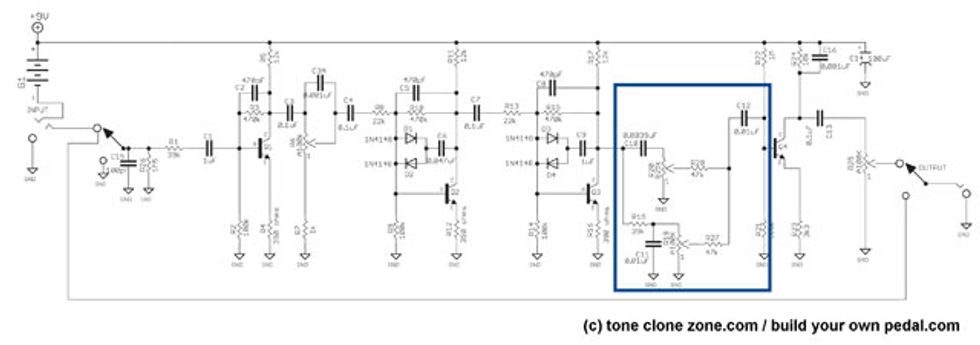The Big Muff Pi is a timeless classic in the fuzz-pedal world. It’s been heard on numerous recordings and been offered by countless boutique pedal manufacturers in one form or another over the years. There are several different versions of it, but for this article we’re going to talk about the newest Russian version (black box).
While it is a good-sounding pedal in stock form, as DIY’ers we have to ask ourselves how it can be improved. What are its shortcomings? What kind of modifications would turn this great fuzz into an amazing fuzz? Let’s look at the circuit and break it down in layman’s terms.

| Click to download high-res schematic |
The signal comes in and passes through R1 and C1 before hitting the first stage, a basic transistor signal boosting stage. Once the signal is boosted, it goes through C3 and uses a potentiometer connected as a volume pot in order to control the gain. The signal goes through C4 and R8 before hitting the next stage, which is boosting the signal but also clipping the signal quite a bit via the diodes (D1 and D2) in conjunction with C6. The signal then goes through C7 and R13 before hitting the next stage, which is nearly identical to the preceding stage. After this stage, the signal goes into the tone control, which pans between a high-cutting section and a low-cutting section. This explains why when you turn the tone control down the sound is very bassy, while turning it up cuts the bass, and it gets very bright. After leaving the tone control, the signal goes through C12 and enters into the final signal boosting stage before exiting through C13 and going out of the volume control into the pedal’s output.
Modifications
A common complaint is that the stock big muff tone control takes out too much of the mids. In a band situation this can make the guitar tones seem to disappear a bit. In order to bring the mids back in, I like to change the tone stack, so it’s more like a traditional high-cut type of control. In addition, I like to control the bass frequencies so they aren’t so overwhelming. Here are the changes I would make:

| Click to download high-res schematic |
• C1: 1ufThis will make it nice, big and full—something closer to a Queens of the Stone Age type of tone. We can also make the gain control more useful in lower gain applications: simply connect a .001uf cap between lugs 2 and 3, shown as C3A on the schematic. For a creamier, Gilmour-ish tonality, jumper R1, and connect a .001uf cap in parallel with R24. If you want more of a higher gain, open-sounding distortion, make all the same changes, except make C1 a .01uf and C12 a 1uf. For an extra bit of creaminess, replace R12 and R16 with jumpers.
• R8: 22k
• R13: 22k
• Remove R19 completely; do not replace it with anything.
• In place of R18, connect a 20k potentiometer as shown in the schematic. This requires drilling a hole and mounting the new pot. Alternatively, you can wire in a 20k trimpot and just set the pot to taste. This modification will allow you to have separate bass and treble controls.
• C12: .01uf (make larger if you need more bass)
• R22: 1M
• C9: 1uf
I prefer poly film or metal stack film capacitors whenever possible. This isn’t absolutely necessary, just a tonal preference. If you use electrolytics, make sure you get bipolar electrolytics. You can get any of these parts from smallbearelec.com, mouser.com, or digikey.com, among other places. I do not recommend Radio Shack-type caps, though; sometimes the parts are so large you can have trouble fitting them in the pedal.
If you happen to like the scooped-mid sound of the Big Muff, but still want a separate bass and treble, I would make the following modification to the tonestack:

| Click to download high-res schematic |
All of the changes in the previous mods still apply, the only thing we are changing is the tonestack, shown in blue on Schematic 3. Some DIY’ers also like to experiment with different types of NPN transistors, which do indeed give a bit of a different sound. They’re inexpensive as well, so it can be very fun. These modifications can be done to any Big Muff-style pedal; just cross-reference the schematics shown here with the particular schematic you have for your pedal. I guarantee you’ll have a killer-sounding tonal twist on a classic fuzz pedal.
Have fun!
Brian Wampler
Brian Wampler is an author, effects designer/builder and operates IndyGuitarist Custom Effects - IndyGuitarist.com and Wamplerpedals.com. His books include How to Build Effect Pedals, How to Modify Effect Pedals, and Advanced DIY Effect Pedals available at GuitarTone.net.







![Rig Rundown: Russian Circles’ Mike Sullivan [2025]](https://www.premierguitar.com/media-library/youtube.jpg?id=62303631&width=1245&height=700&quality=70&coordinates=0%2C0%2C0%2C0)


























